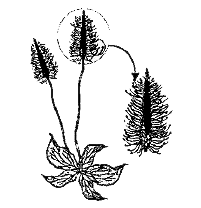What are two kinds of pollination ? Which one is more beneficial for plants ?
Step-by-Step Solution:
1. Understanding Pollination: Pollination is the process of transferring pollen grains from the anther (male part) of a flower to the stigma (female part) of the same or another flower.
2. Types of Pollination:
- Self-Pollination: This occurs when pollen is transferred from the anther to the stigma of the same flower or to another flower on the same plant. In this case, the genetic material comes from one plant.
- Cross-Pollination: This occurs when pollen is transferred from the anther of one flower to the stigma of a flower on a different plant of the same species. Here, the genetic material comes from two different plants.
3. Comparing Benefits:
- Self-Pollination: While it ensures that a plant can reproduce even in isolation, it does not promote genetic diversity.
- Cross-Pollination: This method is more beneficial for plants as it promotes genetic diversity, leading to the development of new varieties and enhancing the adaptability of plants to changing environments. It is also considered a key factor in the process of evolution.
4. Conclusion: Therefore, the two types of pollination are self-pollination and cross-pollination, with cross-pollination being more beneficial for plants.
---
- Self-Pollination: This occurs when pollen is transferred from the anther to the stigma of the same flower or to another flower on the same plant. In this case, the genetic material comes from one plant.
- Cross-Pollination: This occurs when pollen is transferred from the anther of one flower to the stigma of a flower on a different plant of the same species. Here, the genetic material comes from two different plants.
- Self-Pollination: While it ensures that a plant can reproduce even in isolation, it does not promote genetic diversity.
- Cross-Pollination: This method is more beneficial for plants as it promotes genetic diversity, leading to the development of new varieties and enhancing the adaptability of plants to changing environments. It is also considered a key factor in the process of evolution.
Topper's Solved these Questions
- BOOK - MBD -HARYANA BOARDCHAPTER - HOW DO ORGANISMS REPRODUCE?EXERCISE - Long Answer Type Questions2videos
HOW DO ORGANISMS REPRODUCE?
- BOOK - MBD -HARYANA BOARDCHAPTER - HOW DO ORGANISMS REPRODUCE?EXERCISE - EXAMPLE185videos
HOW DO ORGANISMS REPRODUCE?
- BOOK - MBD -HARYANA BOARDCHAPTER - HOW DO ORGANISMS REPRODUCE?EXERCISE - Very Short Answer Type Questions14videos
HOW DO ORGANISMS REPRODUCE?
- BOOK - MBD -HARYANA BOARDCHAPTER - HEREDITY AND EVOLUTIONEXERCISE - EXAMPLE144videos
HEREDITY AND EVOLUTION
- BOOK - MBD -HARYANA BOARDCHAPTER - LIFE PRCOCESS (NUTRIENT, RESPIRATION, TRANSPIRATION AND EXCERTIONEXERCISE - EXAMPLE183videos
LIFE PRCOCESS (NUTRIENT, RESPIRATION, TRANSPIRATION AND EXCERTION
Similar Questions
Knowledge Check
- Question 1 - Select One
Cross pollination is more benifited due to
AFormation of seedBFormaion of good seedCFormation of weak seedDNone - Question 2 - Select One
Which type of pollination is quite rare in flowering plants ?
AWindBInsectCWaterDAnimal - Question 3 - Select One
Observe the given diagram. Predict the kind of pollination that might be happening in this plant.
 AWindBWaterCInsectDNone of these
AWindBWaterCInsectDNone of these
What are the three kinds of vascular plants?
View SolutionDevaluation of currency will be more beneficial if prices of
View SolutionThe pollination of two flowers on different plants is known as or The type of pollination in which genetically different pollen grains are brought to stigma is
View SolutionWhat is the name accorded to the type of pollination that takes place in self-incompatible plants?
View SolutionPollination is essential in angiosperm plants because
View Solution

